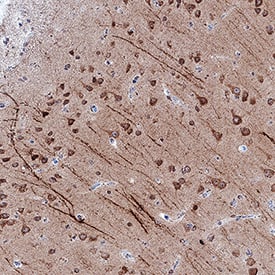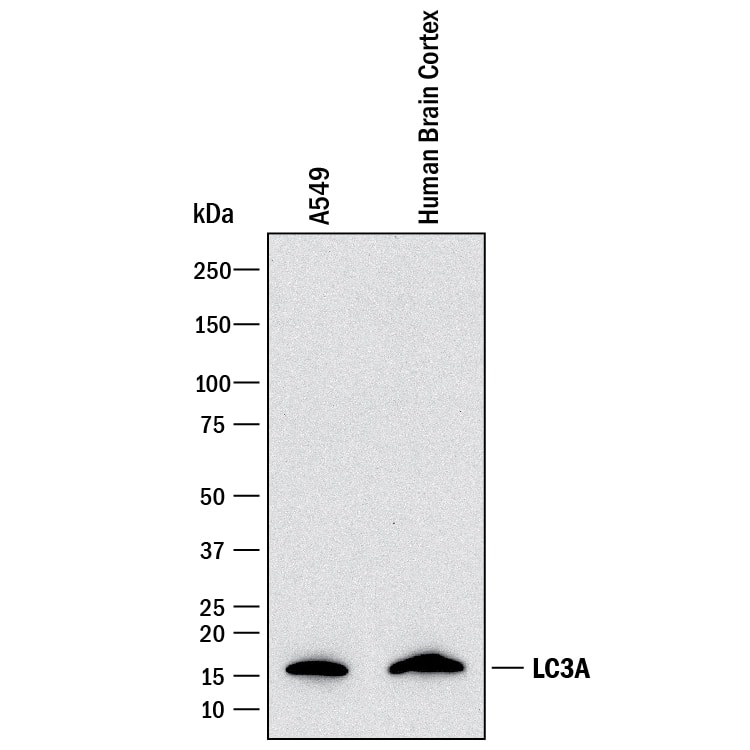Human LC3A Antibody
R&D Systems, part of Bio-Techne | Catalog # MAB9915

Key Product Details
Species Reactivity
Applications
Label
Antibody Source
Product Specifications
Immunogen
Accession # Q9H492
Specificity
Clonality
Host
Isotype
Scientific Data Images for Human LC3A Antibody
Detection of Human LC3A by Western Blot.
Western blot shows lysates of A549 human lung carcinoma cell line and human brain (cortex) tissue. PVDF membrane was probed with 1 µg/mL of Rabbit Anti-Human LC3A Monoclonal Antibody (Catalog # MAB9915) followed by HRP-conjugated Anti-Rabbit IgG Secondary Antibody (Catalog # HAF008). A specific band was detected for LC3A at approximately 16 kDa (as indicated). This experiment was conducted under reducing conditions and using Immunoblot Buffer Group 1.LC3A in Human Brain.
LC3A was detected in immersion fixed paraffin-embedded sections of human brain (frontal cortex) using Rabbit Anti-Human LC3A Monoclonal Antibody (Catalog # MAB9915) at 3 µg/mL for 1 hour at room temperature followed by incubation with the Anti-Rabbit IgG VisUCyte™ HRP Polymer Antibody (Catalog # VC003). Tissue was stained using DAB (brown) and counterstained with hematoxylin (blue). Specific staining was localized to nuclei. View our protocol for IHC Staining with VisUCyte HRP Polymer Detection Reagents.Applications for Human LC3A Antibody
Immunohistochemistry
Sample:
Immersion fixed paraffin-embedded sections of human brain (frontal cortex)
Western Blot
Sample: A549 human lung carcinoma cell line and Human brain (cortex) tissue
Formulation, Preparation, and Storage
Purification
Reconstitution
Formulation
Shipping
Stability & Storage
- 12 months from date of receipt, -20 to -70 °C as supplied.
- 1 month, 2 to 8 °C under sterile conditions after reconstitution.
- 6 months, -20 to -70 °C under sterile conditions after reconstitution.
Background: LC3A
Human Microtubule-associated Protein (MAP) Light Chain 3 (LC3) A is a121 amino acid (aa) protein with a predicted molecular weight of 14 kDa. It is a member of the LC3 subfamily of Autophagy-related 8 (Atg8) proteins (1). The LC3 subfamily also includes LC3B andLC3C. LC3 exhibits 100% aa sequence identity with its mouse and rat orthologs, and is orthologous to the yeast autophagy-related protein Atg8. Atg8 family members show structural similarity with Ubiquitin, but lack aa sequence similarity. LC3 was originally described as part is part of a complex that includes heavy and light chains comprising the MAP1 family of microtubule regulatory proteins (3). However, LC3 has gained attention for MAP1-independent functions in autophagy. LC3 utilizes a ubiquitin-like conjugation system that includes E1-, E2-, and E3-like enzymes to covalently attach phosphatidylethanolamine (PE) to its C-terminus, incorporating it into the phagophore membrane during the early stages of autophagasome formation (4). Recruitment of LC3 to the phagophore may promote membrane elongation (4,5). It may also be involved in cargo recruitment to autophagosomes (1). LC3 is often used as a marker of autophagy.
References
- Shpilka, T. et al. (2011) Genome Biol. 12:226.
- He, H. et al. (2003) J. Biol. Chem. 278:29278.
- Kuznetsov, S.A. & V.I. Gelfand (1987) FEBS Let. 212:145.
- Weidberg, H. et al. (2011) Ann Rev. Biochem. 80:125.
- Weidberg, H. et al. (2010) EMBO J. 29:1792.
Long Name
Alternate Names
Gene Symbol
UniProt
Additional LC3A Products
Product Documents for Human LC3A Antibody
Product Specific Notices for Human LC3A Antibody
For research use only

